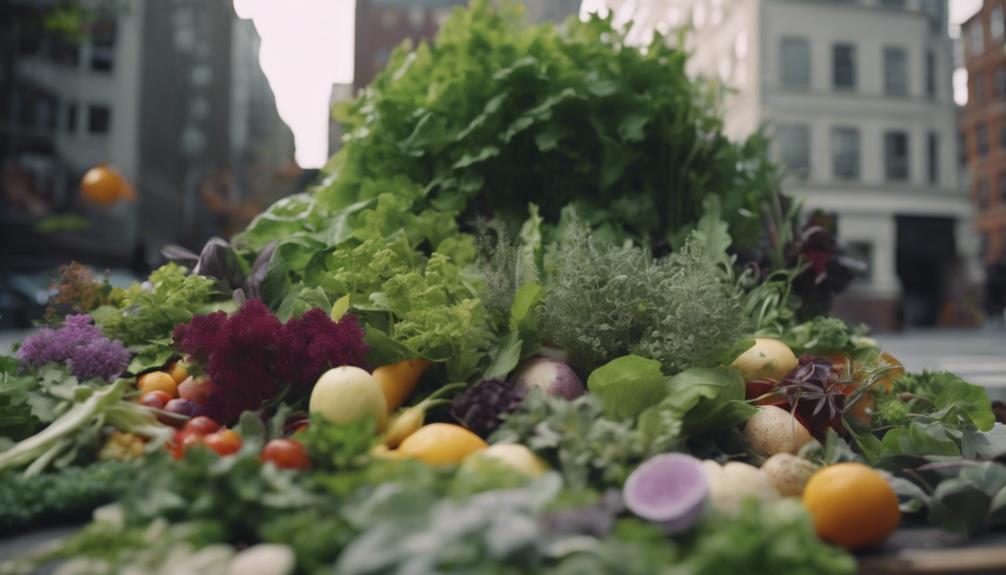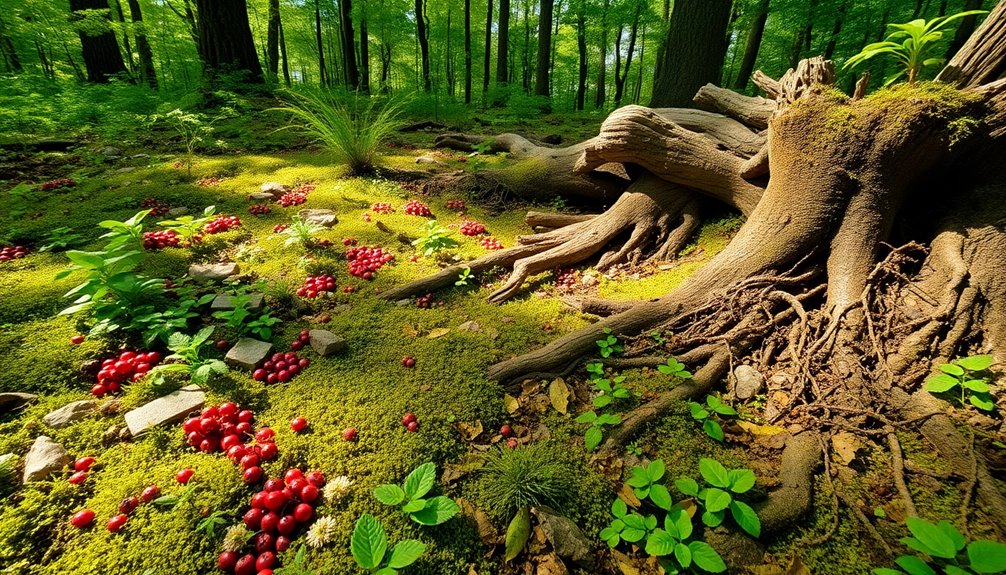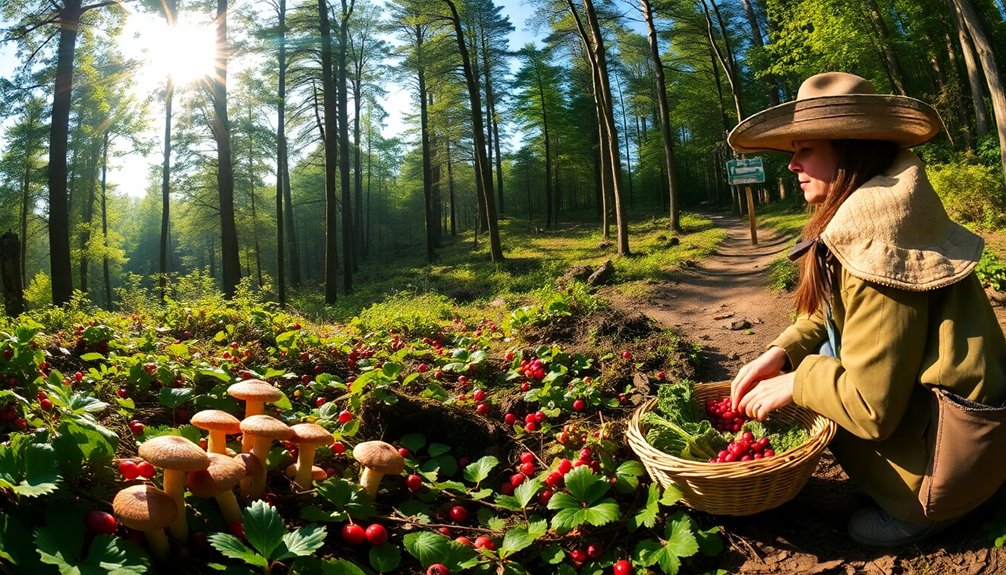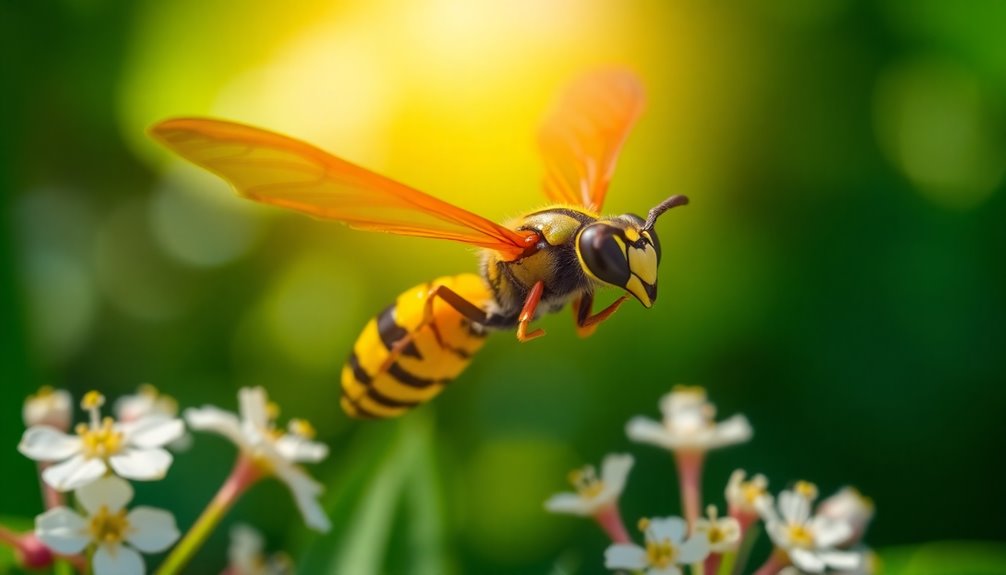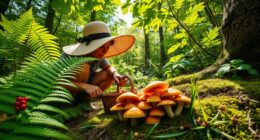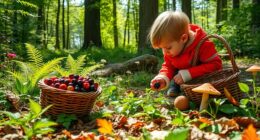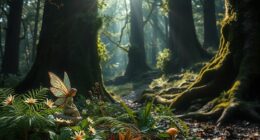Explore the cityscape to discover a world of wild, edible treasures with urban foraging. Embrace this eco-friendly adventure to collect nutritious dandelions, chickweed, and more. Safely gather, wash, and savor a variety of vitamins and flavors provided by nature. Be sure to forage responsibly, following local guidelines and supporting sustainability. Find seasonal delights such as spring greens or winter nuts for a diverse culinary experience. Strengthen your connection to the environment and improve your diet through successful urban foraging. Uncover the secrets of the city’s natural pantry for a rewarding journey into sustainable living.
Key Takeaways
- Identify edible plants in urban areas like dandelions and chickweed.
- Practice sustainable harvesting to maintain ecological balance.
- Obtain permission before foraging on private property.
- Wash foraged plants to remove contaminants.
- Be mindful of legal considerations and restrictions.
Understanding Urban Foraging
To understand urban foraging, grasp the concept of harvesting wild edible plants in city settings. Urban foraging involves scouring urban areas for wild plants that are important and nutritious to eat. It's a practice that not only supplements your diet but also connects you with nature in the midst of the city.
When engaging in urban foraging, it's vital to be able to identify which plants are edible and which are not. Proper plant identification guarantees that you're harvesting plants that are safe for consumption and avoids any potential risks to your health.
In addition to plant identification, public health should also be a top priority when urban foraging. Make sure to wash the wild plants thoroughly before eating them to remove any contaminants they may have picked up from the urban environment. By following these practices, you can enjoy the benefits of urban foraging while minimizing any potential health risks associated with consuming wild plants from city settings.
Edible Plants in Urban Areas

Understand the abundance of edible plants in urban areas to expand your foraging knowledge and culinary possibilities. In cities, you can find a variety of edible plants such as dandelions, chickweed, plantain, purslane, wild garlic, nettle, lambsquarters, burdock, shepherd's purse, and mallow. These plants aren't only rich in vitamins and nutrients but also offer health benefits and medicinal properties.
For example, dandelions and purslane can be eaten raw or cooked, providing a diverse range of flavors to your meals. Urban areas present unique foraging opportunities, allowing you to access fresh, local produce that's both free and abundant. By incorporating these foraged plants into your diet, you can promote nutrition, sustainability, and develop a deeper connection to your local ecosystems.
Urban Foraging Best Practices
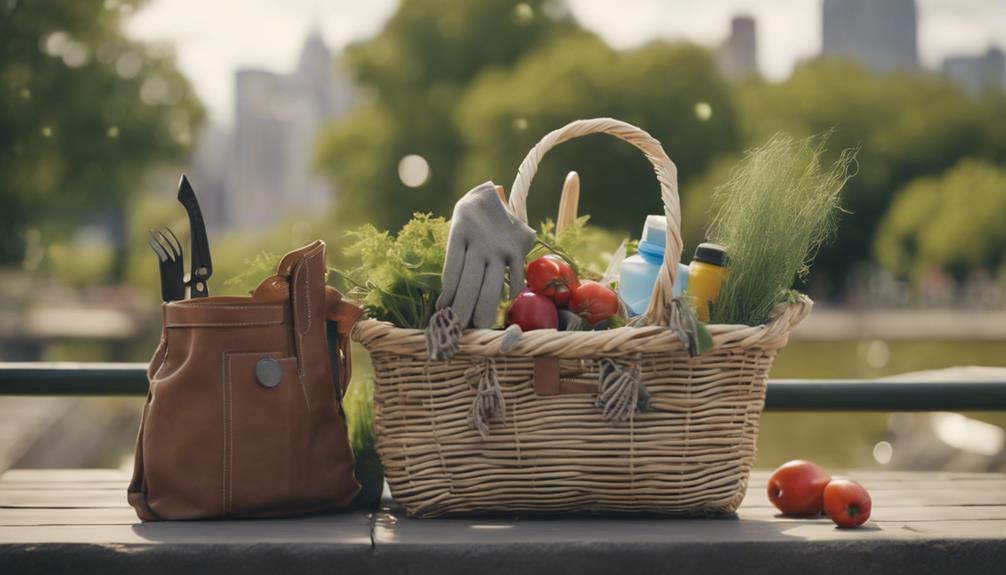
When urban foraging, it's crucial to prioritize safety by correctly identifying edible plants and following sustainable harvesting practices.
By obtaining permission before foraging on private property, you show respect for boundaries and avoid potential legal complications.
Safety Tips for Foraging
Foraging safely in urban areas requires accurately identifying plants to avoid toxic look-alikes and ensuring you harvest edible species. When venturing out to forage in the city, keep these safety tips in mind:
- Responsible Harvesting Practices:
Avoid over-harvesting to maintain the ecological balance of urban green spaces. Respect local regulations on foraging limits and protected areas to support sustainable foraging practices.
- Proper Washing of Foraged Plants:
Urban environments may have pollutants or contaminants that plants can absorb. Wash foraged plants thoroughly before consumption to remove any harmful residues and make sure they're safe to eat.
- Legal Considerations:
Be mindful of the laws governing foraging in public spaces. Familiarize yourself with any restrictions or permits required to forage legally, preventing trespassing or violating regulations.
Identifying Edible Plants
To successfully navigate urban foraging, your first step is mastering the skill of accurately identifying edible plants amidst the city landscape. Being able to distinguish between wild edible plants and potentially harmful look-alikes is essential for a safe and fruitful foraging experience. Here's a handy reference to help you recognize some common edible plants:
| Edible Plants | Description |
|---|---|
| Dandelions | Recognizable by their yellow flowers and toothed leaves. They can be used in salads or brewed into tea. |
| Chickweed | Identified by small, star-shaped flowers and paired leaves. This plant is great for fresh consumption in salads. |
| Purslane | Succulent leaves and stems with a slightly tangy flavor. Perfect for adding to sandwiches or stir-fries. |
| Nettles | Covered in stinging hairs, but when cooked, they lose their sting and are rich in nutrients. Great in soups or as a side dish. |
| Lamb's Quarters | Resembles a dusty miller plant with diamond-shaped leaves. It can be cooked like spinach or added to dishes for a nutrient boost. |
Learning to identify these and other edible plants will enhance your urban foraging skills, ensuring that you gather safe and delicious wild food from your surroundings.
Sustainable Foraging Practices
Practicing sustainable foraging entails responsibly harvesting wild plants to maintain ecosystem health and prevent depletion of natural resources.
To guarantee you're foraging in a sustainable manner, here are essential practices to follow:
- Proper Plant Identification: Accurately identifying edible plants is essential to avoid picking toxic look-alikes, which can be harmful or even deadly if consumed.
- Adhering to Local Regulations: Being aware of and following local regulations is critical to make sure you're foraging legally and ethically, respecting protected species and habitats.
- Washing Foraged Plants: Thoroughly washing foraged plants before consumption is important to remove contaminants and dirt, ensuring the food is safe to eat and reducing potential health risks.
Times for Urban Foraging

When considering the best times for urban foraging, it's essential to recognize the distinct offerings each season brings. Spring brings forth leafy greens and delicate flowers, while summer boasts an abundance of fruits and berries.
Fall shifts focus to nuts, seeds, and root vegetables, and winter offers evergreen needles for teas and hardy greens in milder climates. These seasons provide unique opportunities for foraging in urban areas, each with its own set of edible treasures waiting to be discovered.
Best Foraging Seasons
In urban areas, different seasons offer distinct opportunities for foraging wild edibles, with each time of year providing a unique array of plants to harvest.
- Spring: This season is ideal for harvesting leafy greens like dandelions and flowers such as chickweed in urban environments. These fresh greens and blooms can add a vibrant touch to your foraged meals.
- Summer: Urban foragers can enjoy an abundance of fruits, berries, and herbs like purslane and nettle during the summer months. These flavorful finds can elevate your culinary creations while providing essential nutrients.
- Fall: As autumn rolls in, it becomes the perfect time to gather nuts, seeds, and root vegetables such as acorns and burdock in cities. These hearty ingredients can be incorporated into warming dishes to savor the flavors of the season.
Each season presents a unique opportunity for urban foragers to explore and harvest a diverse range of wild edibles, enriching your connection with nature and the food you consume.
Ideal Foraging Locations
Urban foraging in different seasons not only offers a variety of wild edibles but also highlights the importance of selecting ideal locations and times for your foraging expeditions. In New York, there are numerous urban foraging spots where you can discover a plethora of edible weeds, fruits, herbs, and even medicinal plants. When foraging in public spaces, such as parks or abandoned lots, it's vital to make sure that you have permission to harvest plants and that the area is free from contamination.
Selecting the right time to forage is essential for a successful outing. Depending on the season, different plants will be at their peak for harvesting. For example, spring is perfect for gathering leafy greens like dandelions and chickweed, while fall offers nuts, seeds, and root vegetables such as acorns and burdock.
Make sure to research the specific plants available in your area during each season to maximize your foraging experience. By choosing the ideal locations and times for urban foraging, you can enjoy a bountiful harvest of fresh, local, and sustainable food right in the heart of the city.
Safety Tips Foraging
Guaranteeing your safety while foraging includes being mindful of the best times to explore urban areas for wild edibles.
When it comes to foraging in urban environments, following these safety tips can help you have a successful and secure experience:
- Be Aware of Contaminants: Urban areas may have pollutants like heavy metals or chemicals in the soil. Avoid foraging near industrial sites, busy roads, or places with visible pollution to prevent consuming contaminated plants.
- Proper Plant Identification: Before harvesting any wild foods, accurately identify the plants you intend to gather. Mistaking toxic plants for edible ones can lead to serious health consequences.
- Respect Seasonal Changes: Different seasons offer varying edible plants. Stay informed about what grows in each season to maximize your foraging experience and ensure you're harvesting plants at their peak nutritional value.
Benefits of Urban Foraging
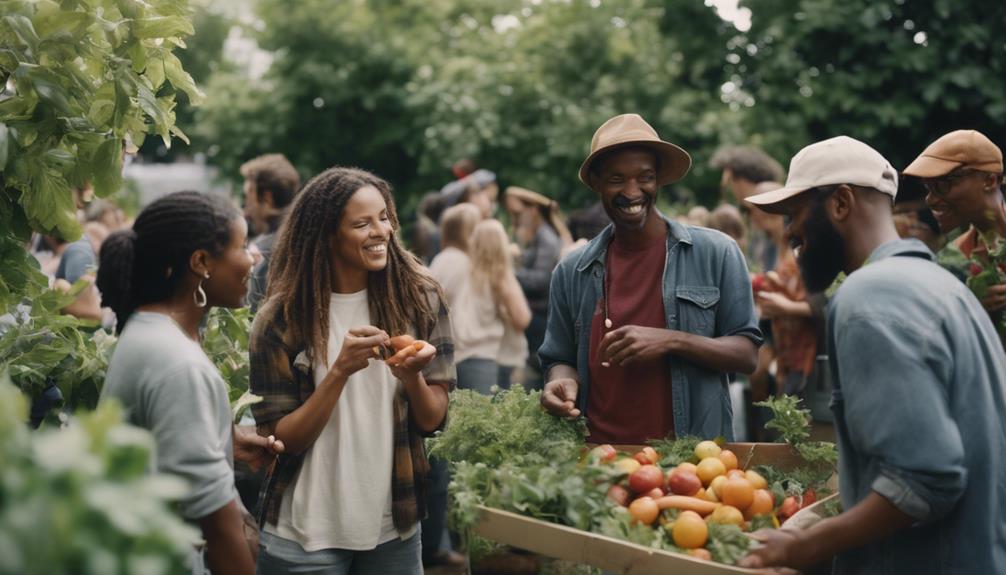
Connecting with nature through urban foraging offers numerous advantages, including free and nutritious food options and a sustainable approach to reducing food waste. Urban foraging not only allows you to enjoy the thrill of discovering edible plants in your city but also contributes to environmental sustainability by promoting a deeper connection to the natural world.
By foraging in urban areas, you not only get to explore and appreciate local ecosystems but also help in reducing food waste, making it a sustainable practice. This unique way of sourcing food opens up a world of diverse and often overlooked food sources right at your doorstep.
Moreover, urban foraging is a safe practice when done correctly. Remember to wash and prepare the foraged foods properly to guarantee a healthy and enjoyable experience. By following safety guidelines, you can make the most of the benefits urban foraging has to offer while minimizing any potential risks associated with consuming wild plants.
Tips for Successful Foraging
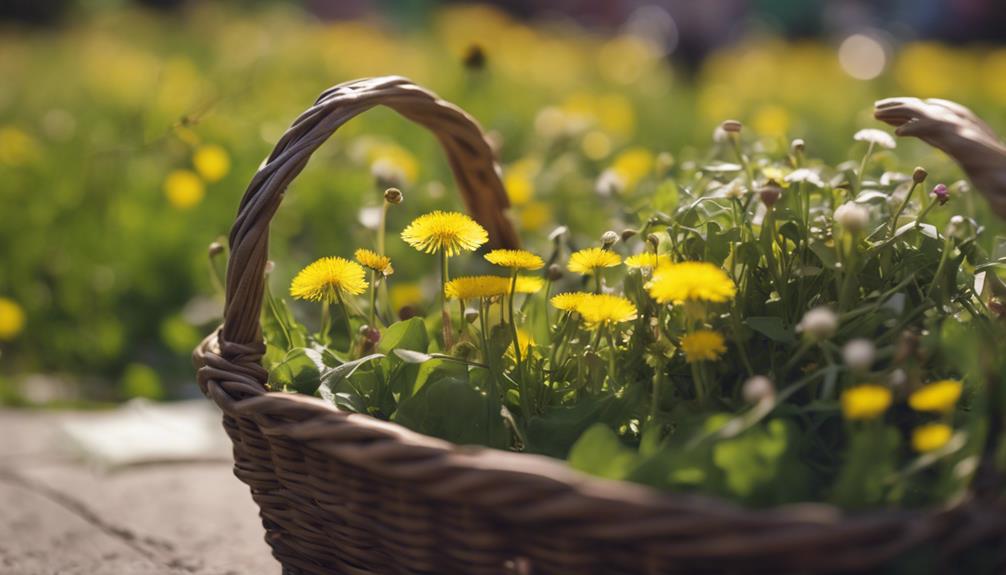
When foraging in urban environments, it's important to prioritize safety and sustainability by following these essential tips for successful foraging:
- Find and Identify Edible and Medicinal Plants: Before harvesting any plants, make sure you accurately identify them to avoid any toxic look-alikes. Utilize guidebooks, online resources, or seek guidance from experienced foragers in your community.
- Consider taking Only What You Need: Practice ethical foraging by taking only what you need and leaving behind enough for wildlife and other foragers. This guarantees the sustainability of the ecosystem and promotes biodiversity.
- Always check for Contamination: When foraging in urban areas, always check for chemical contamination. Avoid plants growing near roadsides, industrial sites, or areas sprayed with pesticides. Opt for cleaner environments such as parks, riverbanks, and community gardens.
Following these tips will help you gather a diverse array of edible and medicinal plants safely, ethically, and sustainably in urban settings.
Remember to wash and prepare your foraged finds properly before consumption to enjoy them safely.
Frequently Asked Questions
Is It Safe to Forage in the City?
Yes, it's generally safe to forage in the city if you avoid polluted areas and correctly identify edible plants. Remember to follow safety tips, like washing plants thoroughly and seeking advice from experienced foragers, for a successful urban foraging experience.
What Is the Golden Rule of Foraging?
Always remember, the golden rule of foraging is to positively identify plants before harvesting. This simple step guarantees your safety by preventing accidental consumption of toxic plants. Proper identification is key for a successful experience.
What Is the Urban Foraging?
Wondering what urban foraging is? It's all about collecting wild plants and mushrooms in your city. From dandelions in parks to acorns from city trees, you can learn about nature and gather wild foods.
What Are the Best Books on Foraging?
For the best books on foraging, check out "The Forager's Harvest" and "Nature's Garden." These guides offer valuable insights on identifying wild edibles, harvesting techniques, and recipes. They're essential resources for your foraging journey.
Conclusion
As you explore the concrete jungle, remember that the city holds a bounty of edible treasures waiting to be discovered. With a keen eye and a little know-how, you can turn urban landscapes into your own personal grocery store.
Embrace the adventure of urban foraging, connecting with nature in unexpected places and nourishing yourself with the fruits of your labor.
So go forth, armed with knowledge and curiosity, and let the city be your playground for sustainable and delicious delights.

